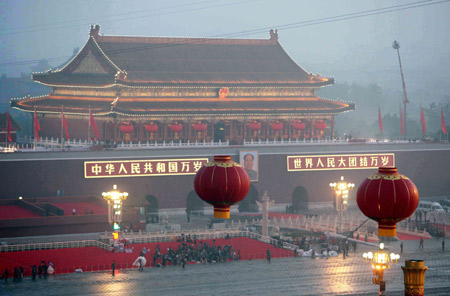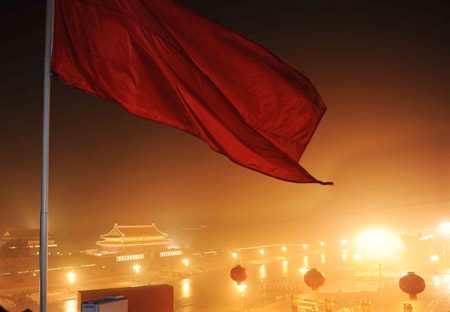
Photo taken on Oct. 1, 2009 shows the general view of Tian'anmen in the early morning. China will celebrate on Oct. 1 the 60th anniversary of the founding of the People's Republic of China. (Xinhua/Yuan Man)
BEIJING, Oct. 1 (Xinhua) -- Clean streets replete with national flags, major road intersections adorned with ornate potted plants, Beijing is in gala attire early Thursday for the massive celebration commemorating the 60th founding anniversary of the People's Republic of China.
The event will showcase the world how the country explores the road of building socialism with Chinese characteristic in the past decades, and what great achievements it has attained.
A shower made the city clean Wednesday night and early Thursday morning after rain-inducing chemicals were fired into the sky above Beijing that was filled by smoke and vapor in the past two days.
Weather cleared up as of 9:00 a.m. and sunshine seems plenty for the well-prepared air force echelons to take off.
200,000 people are gathering on Tian'anmen Square and along Chang'an Avenue in central Beijing to experience the grandiose celebration that will boost their national pride.
Many people across China had an early rise Thursday morning to get prepared to watch the much-anticipated military and civilian parade either alongside the parade route or on TV.
Du Jiayuan, a sales manager at a Guangzhou-headquartered leather product company, said he was excited about the celebration as 60 years means a full cycle of the Chinese zodiac.
"The 60th anniversary of the founding of the People's Republic of China is a very important moment. It is a symbol of maturity for both a person and a country," Du said.
With the grandiose military parade and massive pageant drawing near, Tian'anmen Square is in full swing to embrace the extravaganza which will add an upbeat note to the anniversary.
At the center of Tian'anmen Square, right next to the Monument to the People's Heroes, two gigantic digital screens are displaying the capital's scenic views and landmark buildings. They are planked with 56 columns, 13meters tall and painted in red and yellow, representing the country's 56 nationalities.
William Poirier, vice president of the Nuclear Power Plants China of Westinghouse Electric Company, said he was very impressed by the 56 columns of ethnic unity and the massive digital screens on Tian'anmen Square.
The columns represent a wonderful part of the Chinese culture while the screens China's good technology, he said, adding the upcoming parade would be a grand display of many aspects of China.
Tens of thousands of colorfully-clad youngsters have gathered on the square to prepare for their performance slated for Thursday morning.
J. C. M. Busbhman, a flower bulb expert from the Netherlands, told reporters at the scene that he was "so impressed by the amount of children" on Tian'anmen Square.
He said he had never watched a military parade of such a scale and had great expectations for the upcoming one.
Soldiers, armored vehicles and state-of-the-art weaponry carried on motor vehicles left suburban military camps early in the morning and are lining up at the east Chang'an boulevard, the designated rendezvous.
Soldiers are singing barrack ballads while civilians gather around colorful floats opposite the soldiers are cheering to the rhythm.
The youngest formation of all is composed of freshmen from the elite Tsinghua University. Most of the participants of the formation were born after the year 1990 and did not attend the previous rehearsals.
Guo Xiaoyang, a teacher from the university, said they will bring about the best of modern Chinese young people during the upcoming parade.
Flags on Tian'anmen Rostrum flutter in the autumn breeze. Later in the morning, Chinese top leaders, like their predecessors, stand on the rostrum and watch the grand show of armed forces and masses.
Municipal authorities have exercised traffic control measures along the Chang'an Avenue. Entrances to affected subway stations are locked and taxis are not allowed to operate in the areas cordoned off.
Opposite Wangfujing Street, a prime shopping center in downtown Beijing, a miniature of the Bird's Nest, where the Beijing 2008 Olympic Games opening and closing ceremonies were held, was constructed. Right across the street, there stood the Haibao, mascot of the World Expo 2010 Shanghai.
Potted plants and flowers line up the streets while colorful posters are pasted on walls, and celebration slogans can be seen on billboards. There are also ornamental plants and plant structures in the shape of dragon, Great Wall, and all symbols of the country's pride.
The grand military parade scheduled to be held at 10 a.m. Thursday will be the 14th parade since 1949, the year when the People's Republic of China was founded.
The most recent massive parade was in 1999 when New China marked its 50th birthday.
Military parades normally feature a display of formations of the armed forces, as well as new weapons, artillery, tanks, armored vehicles, and aircraft.
For many Chinese, Thursday's anniversary parade means more than a chance to stir up their national pride, it is a declaration to the world that China was no longer haunted by the predictions of doom spell.
China spent years of the past six decades to seek a road of truth and dignity.
Following the founding of the People's Republic of China on Oct. 1, 1949, there were doubts whether the Communist Party of China could rule and feed a continent-sized country with a population of 500 million.
The country was put to severe tests. The War to Resist U.S. Aggression and Aid Korea (1950-1953), three years of natural disasters (1959-1961), coupled with the aftermath of the Great Leap Forward plus the 10-year turmoil of the Cultural Revolution (1966-1976) have been among the major obstacles circumvented.
During the cold war, the country's survival was threatened by nuclear bombs of the world's super powers.
The collapse of the Soviet Union in 1991, following the political turmoil in China in the summer of 1989, led Westerners to doubt the sustainability of China's persisting on "a socialist road with Chinese characteristics".
In 2001, China's entry into the World Trade Organization prompted Western scholars to question the sustainability of its economic development.
However, strong economic performance, which ensued the implementation of the country's reform and opening-up policy in1978, transformed China from a poverty-stricken country into the world's third largest economy.
From solitude to a rising economic power, China's model of development has won recognition.
In 1971, the People' s Republic of China recovered its seat in the United Nations.
In 2001, China formally became the 143rd member of the World Trade Organization (WTO).
In 2008, Beijing successfully hosted the 29th Olympic Games, one of the most spectacular in the games' history.
And currently, China's huge currency reserves and stimulus packages produced a strong economic performance against the backdrop of global recession and serve as a strong engine for global economic recovery.
Observers say the grand rally is a historical moment to underscore China's endeavor to be engaged in the great cause of the revitalization of the Chinese nation.

A red flag is seen on the top of the Great Hall of the People in the early morning in Beijing, on Oct. 1, 2009. China will celebrate on Oct. 1 the 60th anniversary of the founding of the People's Republic of China. (Xinhua/Xu Jiajun)
